Capital Region Workforce Boards Champion Digital Inclusion

The Capital Region’s four workforce boards recognize the digital divide must be addressed in order to support inclusive job growth and social mobility for our region’s workers. In response, they have provided a significant investment in the Sacramento Coalition for Digital Inclusion’s (Coalition) efforts to address digital skills, technology access, and broadband infrastructure and affordability needs. The Capital Region Workforce Boards include SETA/Sacramento Works, Golden Sierra Job Training Agency, YoloWorks and North Central Counties Consortium. According to Roy Kim, Deputy Director of SETA/Sacramento Works, “Digital skills have become part of the basket of basic skills that job seekers need to obtain employment and advance along a career pathway.” The funding provided will support the effort to sustain, implement and expand the Coalition’s work to ensure traditionally underserved community members receive access, devices and skill building resources to participate in our increasingly digital world.
Valley Vision is actively working to close the digital divide in the Capital region. The Coalition, managed by Valley Vision, recently completed a 2021 Action Plan as a roadmap to advance and expand digital inclusion in three core areas: broadband access and adoption, hardware devices, and digital literacy and skills. Valley Vision also manages the Connected Capital Area Broadband Consortium, connecting the region’s underserved households with high speed broadband infrastructure. By addressing needs in infrastructure, affordability, technology access, and digital skills, our region is taking a comprehensive approach to closing the digital divide – recognizing that these pillars are co-equal in addressing economic and educational inequity.
The Coalition was founded as a response to the 2018 Brookings Institution economic assessment, commissioned by Valley Vision and civic partners in the Sacramento Capital Region. With the onset of COVID-19, the Coalition quickly mobilized and expanded vital digital equity efforts. The effort has expanded since that time and today consists of a steering committee of representatives from the City of Sacramento and the Sacramento Public Library, as founding SCDI members, and the Capital Region Workforce Boards, California State University Sacramento, Los Rios Community College District, and Clear Strategies with participation from over one hundred additional community leaders and stakeholders. Advancing digital skills and closing the digital divide are called out as major regional priorities in the Capital region’s inclusive economic development plan, Our Path Forward: The Prosperity Strategy.
The Workforce Boards have been vital contributors to the region’s economic prosperity with prior initiatives that support entrepreneurship, high-growth industry sectors, and through advancing research on the Future of Work. This critical investment in digital inclusion will help to advance an inclusive, regional workforce and further equity efforts in our shared economy.
To keep up with Valley Vision’s work to advance a future-ready workforce in the Sacramento region, subscribe to our 21st Century Workforce email newsletter!
Renee John is a Valley Vision Project Leader managing initiatives within the 21st Century Workforce impact area.
Note: The Connected Capital Area Broadband Consortium is funded by the California Public Utilities Commission (CPUC).
The Latest on Broadband Coverage in the Capital Region

In November 2020, the California Public Utilities Commission (CPUC) released the latest broadband availability data that reflect broadband coverage in California as of December 2019. This blog will present an overview of the broadband coverage in the Connected Capital Area Broadband Consortium (CCABC) Region, and in the four counties (Sacramento, Sutter, Yolo and Yuba), based on the following speed standards:
- 6/1 Mbps (megabits per second): Current California standard (AB1665).
- 25/3 Mbps: FCC standard. Minimum recommended in a previous blog for households using video conference applications for education or work, and/or having multiple simultaneous users at home.
- 100/20 Mbps: Goal set in the Governor’s Executive Order and the California Broadband 4 All Action Plan.
- 1Gbps/500Mbps: FCC Gigabit service standard.
Based on these standards, the table below presents the coverage and percentage of served and unserved households. At the standard of 6/1 Mbps, the region is at 97.4% coverage (around 17,000 unserved households) which is close to the goal of 98% broadband access in California and in each consortium region. Sacramento has the highest coverage, 97.7%, followed by Sutter, 97%, Yolo, 96.4%, and Yuba, 94.7%. For the 25/3 Mbps standard, the figures are slightly below, achieving a 96.9% in the region (around 20,000 unserved households). At the 100/20 Mbps standard, the regional coverage turns into 93.2%, increasing the number of unserved households to around 44,000. For these three standards, regional coverage is comfortably above 90% coverage, however, for the Gigabit standard, the regional coverage dramatically drops to 22.5% or half a million unserved households.

The figure below shows the layered coverage at the speed standards mentioned above. The higher speeds coverage, 100/20 Mbps and Gigabit (in blue and gray, respectively), is mostly in main urban and densely populated areas across the region. Speeds of 6/1 Mbps and 25/3 Mbps (in light blue and green, respectively) are also available in these areas, and additionally, in suburban and some rural areas. Areas unserved at 6/1 Mbps or with no service are mostly scattered across rural areas across the four counties.
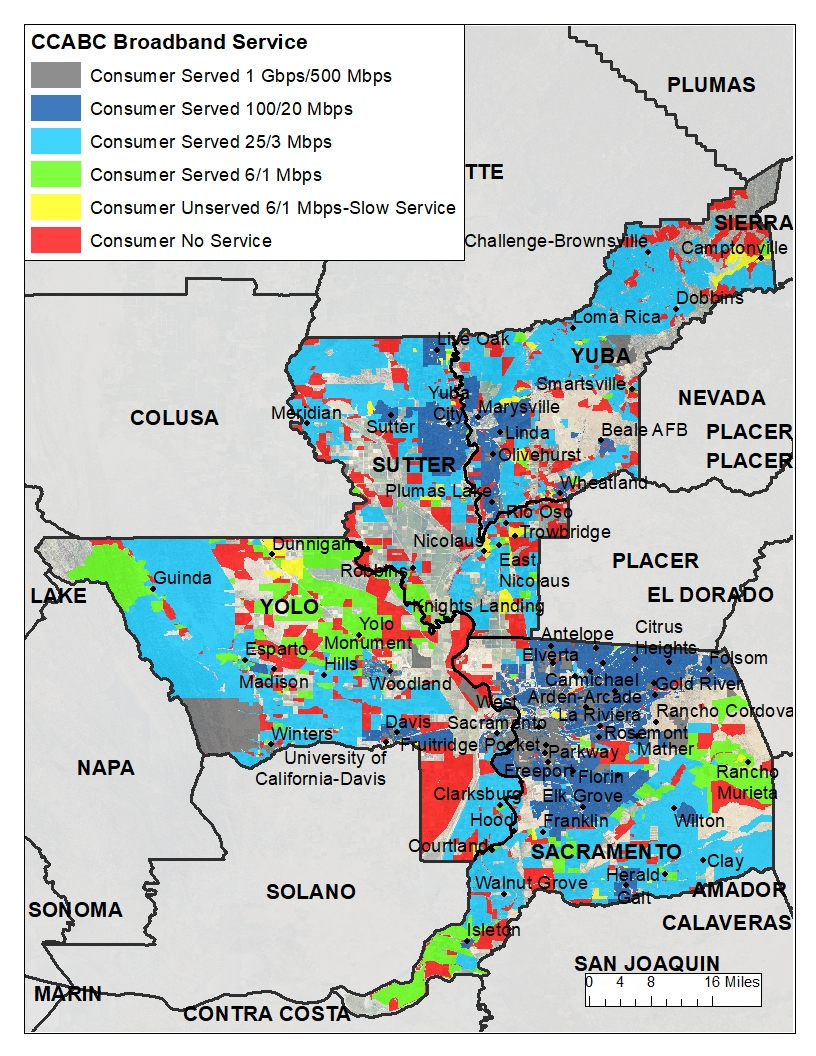
The table and figure below present the broadband coverage by four technologies widely used to provide internet service: DSL, Cable Modem, Fiber to the location (FTTx), and fixed wireless (unlicensed and licensed). Cable Modem has the highest coverage in the region, 94%, and in each of the four counties, followed by legacy DSL, 76%. FTTx achieves a regional presence of around 35%, followed by fixed wireless, 4%. It is important to note that in the figure below, fixed wireless shows the largest footprint in the region, however, this coverage is mostly in less densely populated rural areas. As a result, fixed wireless covers less number of households than the other technologies.
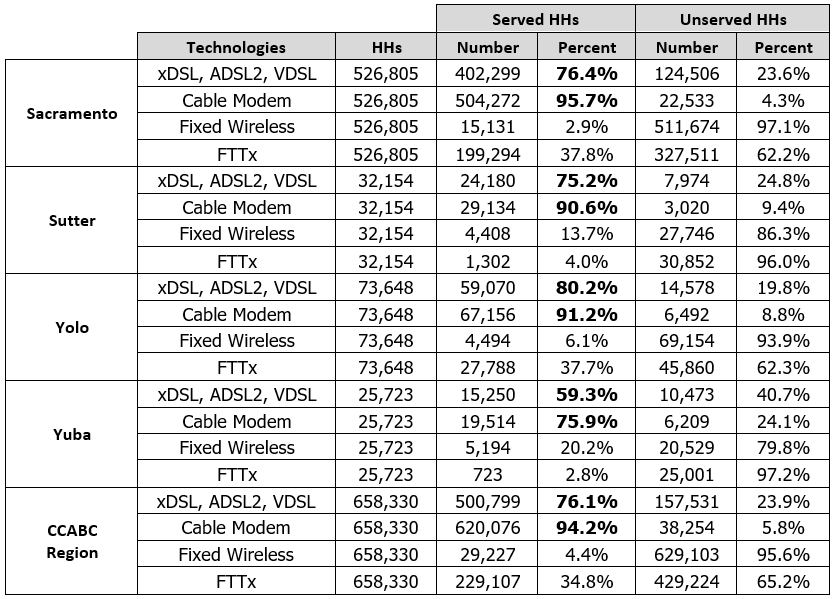
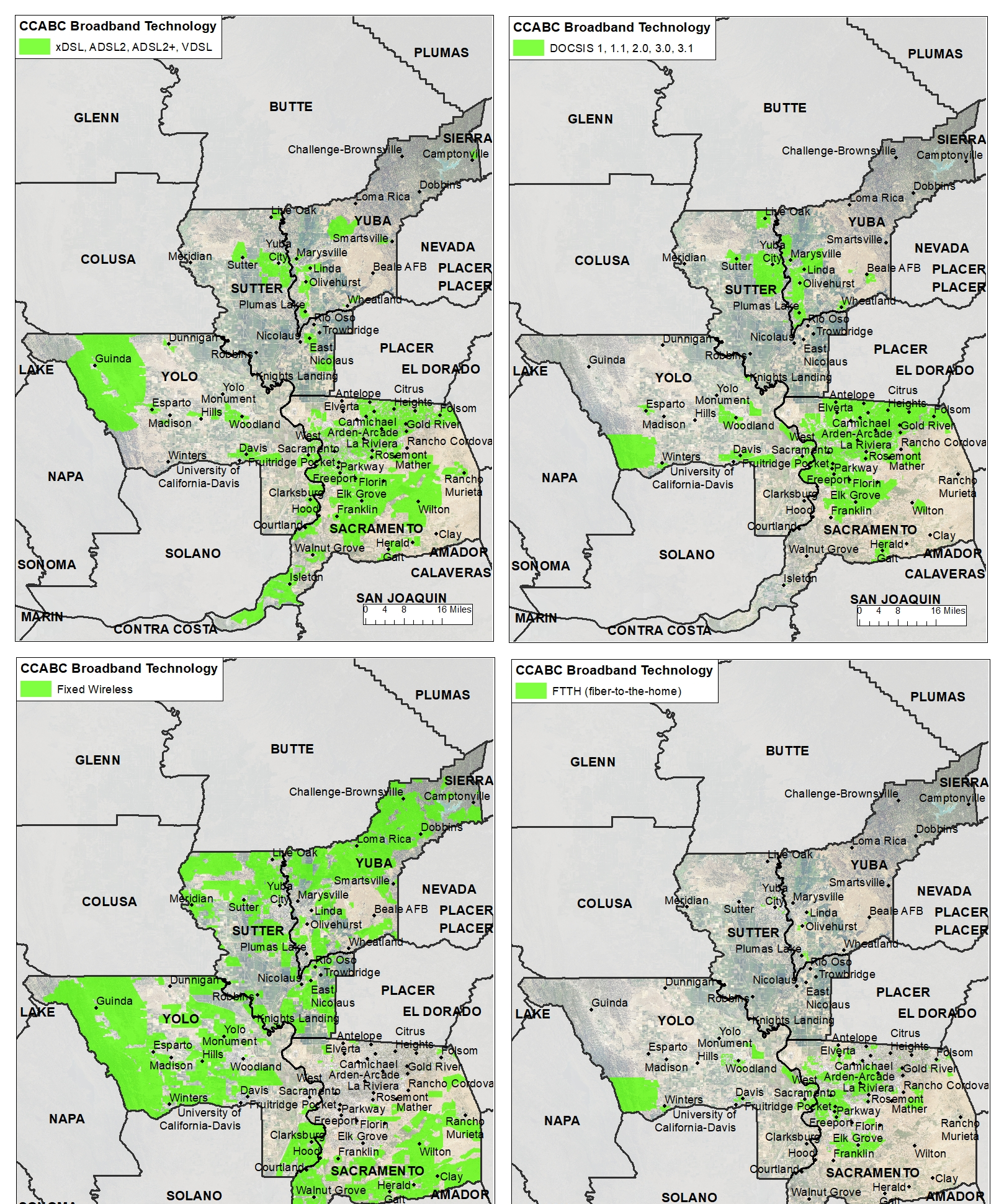
It is important to note that the CPUC broadband availability data is self-reported from ISPs and telecom companies. Many local broadband stakeholders (local governments, communities, residents, and other ISPs) have expressed concerns that some of the data do not reflect what is actually available. For those cases, the CPUC has implemented several validation methods which can be found here. The CCABC recommends internet users to download and run the CalSPEED app (calspeed.org) in order to validate broadband coverage and speeds in the region. In conclusion, these latest CPUC broadband availability figures show that, based on the California 6/1 Mbps standard, our consortium region is still below the 98% availability for households. For the other standards, availability continues dropping to near 93% for 100/20 Mbps, and 22% for an ideal Gigabit service.
This 2021, the Connected Capital Area Broadband Consortium (CCABC) looks forward to continuing working with all broadband stakeholders to get closer to the goal of achieving ubiquitous reliable high-speed and affordable broadband internet for all.
To continue staying up to date with all of the region’s broadband efforts, subscribe to Valley Vision’s e-Connect email newsletter!
David Espinoza is a former Valley Vision Project Leader who managed broadband projects and other initiatives in the Innovation & Infrastructure impact area.
The Year In Broadband…

Broadband has long been recognized as indispensable to equity and economic development. In recent years, significant progress has been made to ensure statewide access. Still, over 8 million California residents do not have broadband subscriptions. We have a long way to go before broadband in California is truly ubiquitous.
In 2020, there has been accelerated momentum around the issue. The onset of the COVID-19 pandemic forced many Californians to pivot some of the most crucial elements of their life — work, school, healthcare, access to services — to an online setting. This shift is an urgent reminder that, in this day and age, broadband infrastructure and adoption is as crucial as roads or electricity.
Valley Vision works with counties, cities, anchor institutions, community groups, businesses, policymakers, and others to bridge the Digital Divide and promote equal access to technology. In 2020, this was embodied in our work contributing to state broadband policy, together with the California Broadband Council, California Forward, the California Emerging Technology Fund, and legislative leaders; our continued role as manager of the Connected Capital Area Broadband Consortium; and our management of the Sacramento Coalition for Digital Inclusion, among others. Broadband infrastructure and adoption is also identified as a high priority of the region’s Prosperity Strategy.
State-level highlights:
- Valley Vision worked closely with California Forward, the California Emerging Technology Fund, and regional broadband consortia to provide input on AB 14, the Internet for All Now Act of 2021. The Bill would authorize the ongoing collection of an existing surcharge on revenues collected by telecommunications providers from customers. The surcharge funds the California Advanced Services Fund, which provides rural and urban communities with infrastructure and other grants administered by the California Public Utilities Commission. This new legislation was announced by Assemblymember Cecilia Aguiar-Curry at the California Economic Summit during a panel on Bridging the Digital Divide, together with Senator Mike McGuire; Trish Kelly, Managing Director of Valley Vision; and Deputy Director Stephanie Tom of the California Department of Technology. Senator Lena Gonzalez introduced similar legislation — SB 4, the Broadband for All Now Act. Both legislators will be principal co-authors on each Bill. This is a major milestone and we hope for quick action in 2021.
- Valley Vision, in collaboration with the California Broadband Council and California Forward, facilitated input for the State’s Broadband Action Plan. An updated draft of the Plan was presented at the Broadband Council’s meeting on Thursday, December 17. The Plan provides a rich overview of the state of broadband across the State, a financial cost model for reaching all Californians with high-speed Internet, and many recommendations for action in 2021.
- Valley Vision co-led this year’s Ensuring Broadband For All working group at the California Economic Summit. The group’s efforts focused on increasing broadband access and adoption in both rural and urban areas. The group developed core principles to drive funding and policy solutions; encouraged collaboration on legislative solutions; supported the State Broadband Action Plan; and worked with the California Public Utilities Commission and others on innovative approaches to infrastructure investment, including leveraging federal resources.
Regional highlights:
- Valley Vision manages the Connected Capital Area Broadband Consortium. Funding for the Consortium was renewed by the California Public Utilities Commission in October 2019, for a three-year period. The Consortium is charged with engaging stakeholders to achieve the broadband connectivity goal of 98% of all households, assisting internet service providers in the region with their California Advanced Services Fund infrastructure grant applications, among other goals. In 2020, Digital Path and Frontier submitted a total of three applications to carry out broadband deployment in Sacramento, Sutter, and Yolo Counties. The Consortium will continue to work with incumbent, competitive, and new entrant internet service providers.
- Valley Vision, together with its partners, finalized and published the Sacramento Region’s Prosperity Strategy — the economic roadmap that ensures a strong, inclusive, and equitable economy. The Strategy calls out broadband infrastructure and adoption, including digital skills acquisition, as high priorities for the region, and was approved by the U.S. Economic Development Administration.
- Valley Vision is working with local government partners in Sacramento, Sutter, Yolo, and Yuba Counties to identify priority areas for broadband expansions or upgrades, including 5G. This includes generating an infrastructure and asset inventory in collaboration with the California Public Utilities Commission, the Sacramento Area Council of Governments, Caltrans, CENIC, the Sacramento Municipal Utility District, the Sacramento Housing and Redevelopment Agency, the Los Rios Community College District, Sacramento State, the City of Sacramento, the Sacramento Promise Zone, among others.
- Valley Vision, the California Emerging Technology Fund, and the Sacramento Area Council of Governments virtually co-convened broadband partners and stakeholders to discuss strategies for accelerating broadband infrastructure investments across the region. The event also showcased highlights of “Getting Connected,” a resource guide for local and regional government leaders featuring best practices, policies, and innovative models to catalyze infrastructure investment and adoption. The resource guide will be rolled out statewide in January 2021.
- Valley Vision put out a Business Broadband Service Survey to assess the current status of broadband service availability and subscription for businesses and community anchor institutions. Results from the survey will help determine and recommend improvements to broadband stakeholders, such as providers and local governments. Outreach for this survey will continue in 2021, through social media, newsletters, and outreach to business chambers.
- Valley Vision launched a campaign — via social media, its newsletters, and outreach to partners and stakeholders — around ground-truth testing of broadband speeds using the CalSPEED app. The app securely tests residential and mobile broadband speeds. Often, the speeds reported by internet service providers are not accurate. Information from the CalSPEED app creates an accurate assessment of actual broadband availability and adoption. Results are used to update the California Public Utilities Commission statewide coverage map and inform infrastructure investments. The campaign resulted in more than 500 CalSPEED tests in our Consortium region. It will continue throughout 2021.
- Valley Vision is completing its Preferred Scenario report for the region, in partnership with the California Emerging Technology Fund. The Preferred Scenario report identifies gaps in broadband deployment and access and the available local assets to address these gaps for the region’s Preferred Scenario corridor — the I -5 corridor. This corridor was identified through the Strategic Broadband Corridors project with Caltrans and the Sacramento Area Council of Governments. This report will identify strategies for leveraging investments.
- Valley Vision, in partnership with the University of California Agriculture and Natural Resources and the National Rural Telecommunications Cooperative, hosted a webinar focused on exploring innovative broadband infrastructure solutions, specifically the co-op model.
- The Federal Communications Commission announced the results of the Rural Digital Opportunity Fund Phase I auction. Winners in our Consortium region (Sacramento, Sutter, Yolo, and Yuba Counties) include Cal.Net, Geolinks, Frontier, LTD Broadband, and Space Exploration Technologies (Space X). Most locations will be receiving broadband with speeds of 100/20 Mbps, and gigabit-speed broadband. Click here to see the map.
Local highlights:
- Valley Vision is developing a Broadband Master Plan for Yuba County, in partnership with the County and Yuba Water Agency. The plan will be completed in the second quarter of 2021.
- Valley Vision is managing the Sacramento Coalition for Digital Inclusion, in collaboration with the city of Sacramento, the Sacramento Public Library, the Los Rios Community College District, California State University Sacramento, and Clear Strategies, among other community partners. The Coalition will be rolling out the 2021 Action Plan for broadband access, adoption, affordability, and digital inclusion and skills, including scale-up opportunities beyond Sacramento County.
- Valley Vision, in collaboration with the Delta Protection Commission, developed a broadband coverage report that will help to identify areas where service most needs improvement. This will empower community leaders and internet service providers to leverage existing opportunities for service expansion and upgrades, and to seek broadband deployment funding.
Valley Vision hosted a webinar on “Community Broadband in Yolo County,” in partnership with the Woodland Technology Alliance. The webinar was a conversation about the current state of the County’s technical infrastructure, as well as solutions to address the community’s broadband gaps. A full recording can be found here, and a summary of the discussion can be found here.
To continue staying up to date with all of the region’s broadband efforts, subscribe to Valley Vision’s e-Connect email newsletter!
Trish Kelly is Valley Vision’s Managing Director, leading its food, agriculture, workforce, and broadband initiatives.
David Espinoza is a Valley Vision Project Leader managing broadband projects and other initiatives in the Innovation & Infrastructure impact area.
Isa Avanceña is a Valley Vision Project Associate supporting the Board of Directors, and the Innovation & Infrastructure and Leadership and Civic Engagement Impact areas.
Highlighting Sacramento Region Digital Inclusion Efforts
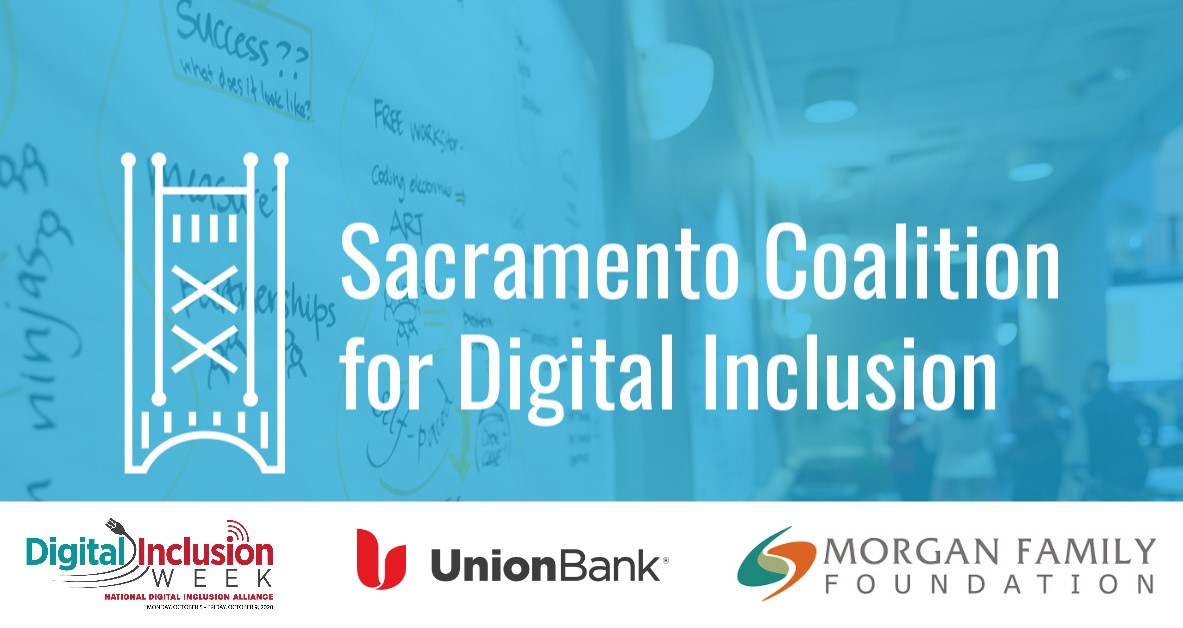
There has never been a more critical time for discussion of digital inclusion which has recently been referred to by the Center for Public Integrity as the “civil rights issue of our time.” As the Pandemic has upended education and workforce, it has left in its wake a widening chasm between community members with resources and those without. In recognition of National Digital Inclusion week, Valley Vision highlights the history, continuing collaborative work, and new momentum of the Sacramento Coalition for Digital Inclusion, a regional approach to creating more opportunities for digital equity.
Discussion which formed the beginnings of the Sacramento Coalition for Digital Inclusion began in the fall of 2018 inspired by a Brookings Institution report on the strengths and weaknesses of the Sacramento Capital region. A series of community discussions occurred to organize around the mission of digital equity, with the Sacramento Public Library hosting the Sacramento Digital Inclusion Summit in January 2019. This led to the creation of the Sacramento Coalition for Digital Inclusion, with more than 40 members, led by a Steering Committee comprised of the City of Sacramento, the Sacramento Public Library, Valley Vision and Social Ventures Partners. During 2019, the Coalition built collaborative relationships, conducted assessments of needs including through community engagement, and produced an initial report focused on increasing digital access, both to affordable Internet and devices, and digital literacy/skills. The City of Sacramento passed a resolution in October 2019 to launch National Digital Inclusion Week in the region.
With the onset of the Pandemic, the work of the Coalition became even more important and the need for a funding mechanism to drive forward momentum and staff this increasingly important body of work required an urgent solution. Valley Vision has been successful in securing short term funding to continue and expand this valuable work through the Morgan Family Foundation and Union Bank, on behalf of community partners and stakeholders.
Current Coalition Steering Committee members include the City of Sacramento, the Sacramento Public Library, and Valley Vision, joined by representatives from Los Rios Community College District and California State University Sacramento, with the Coalition being a vibrant group of over 60 community members and leaders. Three working groups were successfully relaunched in a well attended September Coalition meeting to establish key objectives and drive the work plan of the Coalition in the areas of Internet Access and Adoption, Technology Devices, and Digital Literacy/Digital Skills.
Valley Vision is thankful to the dedicated efforts of the Steering Committee and all members committing their time and talent to align and drive investment in a regional and sustained response to urgent digital inclusion needs. We invite you to join in this work at our next Coalition meeting on October 23rd 11 am to 12:30 pm and help us build a regional digital inclusion work plan to address disparities throughout our region and build a better future for all.
Sacramento Coalition for Digital Inclusion Steering Committee:
- Aubrey Taylor, City of Sacramento
- Jarrid Keller, Sacramento Public Library
- Karina Talamantes, City of Sacramento, Sacramento County Board of Education
- Kevin Flash, Sacramento City College
- Tamara Armstrong, Los Rios Community College District
- Dr. Yvonne Harris, California State University Sacramento
- Trish Kelly, Valley Vision, Managing Director
- Renee John, Valley Vision
- Dr. David Espinoza, Valley Vision
- Jesse Flores, Valley Vision
To keep up with Valley Vision’s work to advance a future-ready workforce in the Sacramento region, subscribe to our 21st Century Workforce email newsletter!”
Renee John is a Valley Vision Project Leader managing initiatives within the 21st Century Workforce impact area.
Continuing Our Work Toward “Broadband for All”

As our region grapples with the COVID-19 pandemic and its effects on daily life and the economy — now compounded by the ongoing wildfires — the digital divide continues to grow. The ability to do distance learning, telecommuting, and telehealth is critical, and it is becoming increasingly clear that there can be no real equity without ubiquitous broadband. State, regional, and local solutions must be pursued concurrently, in an “all hands on deck,” multi-pronged approach.
State-level updates
On August 14, Governor Gavin Newsom issued Executive Order N-73-20, to address the broadband access, adoption, and training needs of Californians — all made more urgent by the COVID-19 pandemic. The following are some of the Order’s major provisions:
- The order directs the California Broadband Council (CBC) to create a new State Broadband Action Plan by December 31, 2020, incorporating a goal of 100 Mbps download speed for infrastructure investment. The Plan will include a roadmap to accelerate deployment and adoption of broadband by state agencies; support such deployment and adoption by local governments; and provide publicly accessible information on all federal and state funding opportunities.
- The Public Utilities Commission (CPUC) is directed to lead broadband data aggregation and mapping efforts, and to provide information on public and private broadband network infrastructure and the cost of deploying network components. This effort will be supported by the California State Transportation Agency and other relevant state agencies; local and tribal governments; and regional consortia, like the Connected Capital Area Broadband Consortium (CCABC), managed by Valley Vision.
- The California Governor’s Office of Business and Economic Development (GO-Biz) is directed to identify funding opportunities to support broadband, equipment, and digital literacy, in collaboration with all cabinet-level agencies, independent departments, and independent constitutional officers.
In addition to these major provisions, the Order directs other state agencies to address the need for deployment and adoption by activating policies and leveraging resources — with particular emphasis on connecting residents with affordable internet service offerings, and ensuring that students have the connectivity and devices necessary for distance learning.
On August 26, the CBC held a special session focused on the planning and implementation of the Governor’s Executive Order. CBC members and a wide range of broadband stakeholders attended the virtual meeting and provided input. The session generated the following proposed approach:
- Developing an outline;
- Articulating a vision;
- Compiling a fact base;
- Developing a timing and cost model;
- Mapping out funding and actions for 2021;
- Conducting research on adoption gaps; and
- Facilitating stakeholder sessions with local governments and the private sector.
The regional broadband consortia, including the CCABC, will continue to actively support these efforts.
Valley Vision has been working with the office of Assemblymember Cecilia Aguiar-Curry (Winters), the California Emerging Technology Fund, and a statewide network of more than 40 partners to support AB 570 – the Internet for All Act of 2020. AB 570 prioritizes the deployment of broadband infrastructure in the state’s most vulnerable, unserved, and underserved rural and urban communities. It extends the collection of funds for the California Advanced Services Fund (CASF), to provide grants to bridge the Digital Divide. While the next stage of the legislative process is yet to be determined, the bill has helped make the case to the Legislature and Governor’s Office for increasing funding, to meet the needs that California is facing now and into the future.
County-level efforts
As manager of the CCABC, Valley Vision hosted a webinar on August 11 on “Community Broadband in Yolo County,” in partnership with the Woodland Technology Alliance. The webinar was a conversation about the current state of the county’s technical infrastructure, as well as solutions to address the community’s broadband gaps. The webinar was a starting point for further exploring innovative strategies, and panelists represented several sectors of the region, including the local government, school district, and state government. A full recording can be found here, and a summary of the discussion can be found here. Valley Vision continues to work with Yolo and other counties to bring these issues to the forefront, and convene partners, stakeholders, and community members to build consensus and take next steps.
Ground truth testing with CalSPEED
Valley Vision is working with local partners and communities from our region to demonstrate the need for better internet service in the region. Community members are encouraged to download the CPUC’s CalSPEED app, which securely tests residential and mobile broadband speeds. Results from the speed test crowdsource a statewide coverage map to inform infrastructure investments. A flyer containing information on the CalSPEED test can be found here.
Additionally, the CPUC, in partnership with CSU, Chico and CSU, Monterey Bay are looking for volunteers to take part in the CalSPEED Home Broadband Study — a statewide effort to collect quality measurements utilizing the new CalSPEED Home Measurement Device.
Please share this information with your partners, stakeholders, and networks.
Low-cost internet service programs
In response to the increased need for distance learning, telecommuting, and telehealth capacity, several Internet Service Providers have begun offering low-cost internet service to families for qualifying low-income households. More information can be found here and here. Please share this information with your partners, stakeholders, and networks, to make sure that all community members are made aware of this option.
This blog focuses on just some of the updates at the state, county, and local level. To continue staying up to date with all of the region’s broadband efforts, subscribe to Valley Vision’s e-Connect email newsletter!
Trish Kelly is Valley Vision’s Managing Director, leading its food, agriculture, workforce, and broadband initiatives.
David Espinoza is a Valley Vision Project Leader managing broadband projects and other initiatives in the Innovation & Infrastructure impact area.
Isa Avanceña is a Valley Vision Project Associate supporting the Board of Directors, and the Innovation & Infrastructure and Leadership and Civic Engagement Impact areas.
A Crash Course in Community-Building
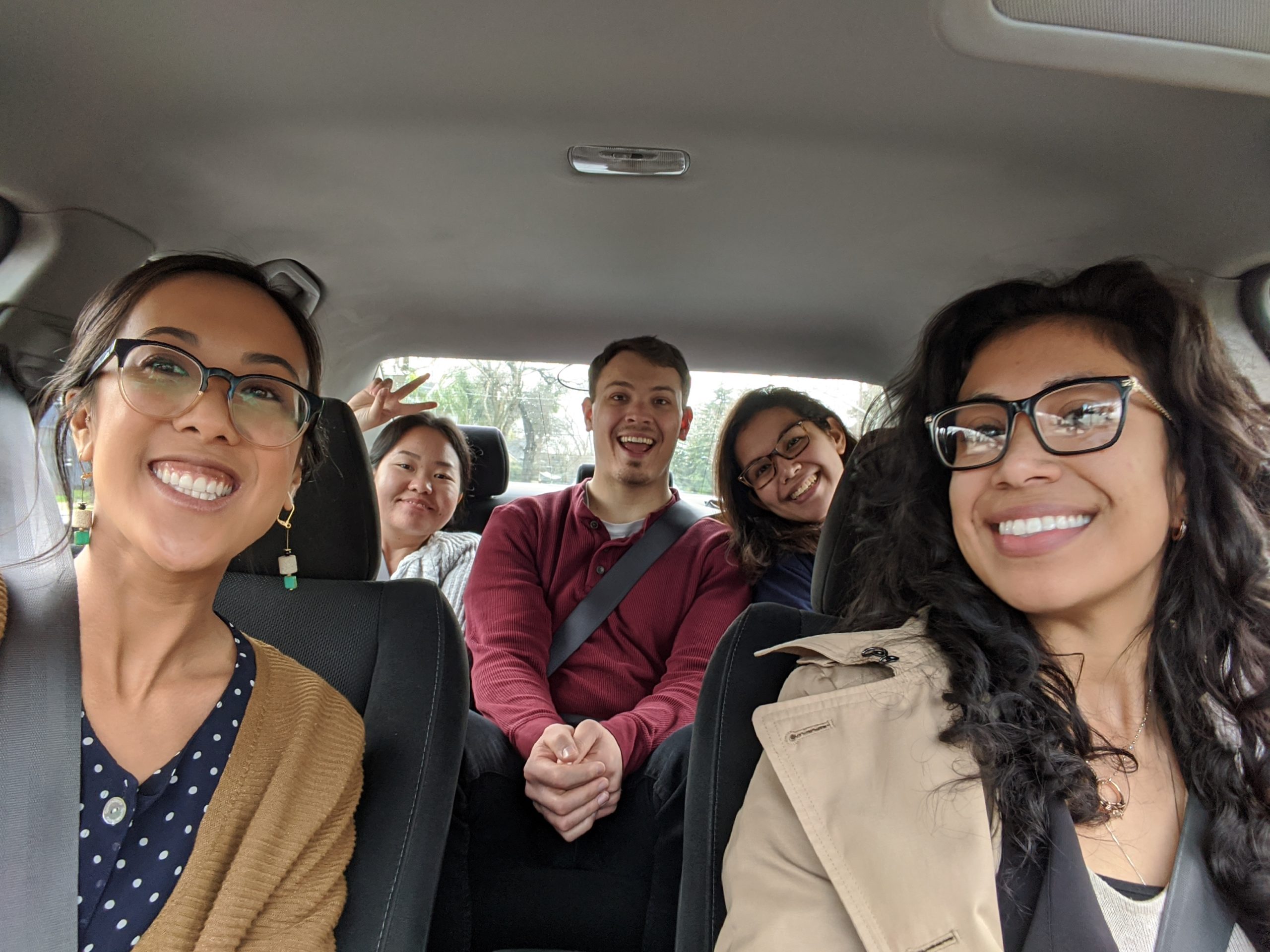
I moved to Sacramento in 2012 with every intention of building a career for myself that focused on helping people. As a Filipina-American I initially thought that my service would be through nursing, but my love of science couldn’t change my disposition in hospitals. I had a limited perspective of what service for my community meant, but Sacramento State taught me the importance of mentorship; Food Literacy Center exposed me to community development and Sacramento’s strong nonprofit system; and Valley Vision gave me the background and foresight to envision a better community across all systems.
Valley Vision has broadened my perspective and taught me that helping people takes more than single-handed transactional services. It requires collaboration, patience, and trust – all easily stated, but not so easily achieved. Yet this small, but mighty team takes on that task wholeheartedly! Valley Vision brings together workforce, education, employers and partners to align workforce initiatives; guide digital inclusion and broadband initiatives to connect our communities; and lift the voices of people throughout our region by advancing public opinion polling data. My experience at Valley Vision was a crash course in the expansive and unique systems that make up our community, exposing me to incredible organizations and populations that make Sacramento home to so many. Content expertise alone though is not enough to ensure collaboration or trust among these entities. In turn, Valley Vision is filled with devoted, adaptive, and compassionate individuals.
I am forever grateful to have learned from and worked alongside this team. It has been an honor working on our workforce and broadband initiatives and my experience at Valley Vision has helped guide my path towards education. I am looking forward to advocating for digital inclusion in a new capacity as a teaching assistant, and later teacher, integrating what I have learned from Valley Vision’s future of work and regional digital skills initiatives into the classroom.
Yzabelle Dela Cruz was a Valley Vision Project Associate supporting the 21st Century Workforce, Innovation & Infrastructure, and Food & Agriculture impact areas.
New Beginnings

I’m very excited to be writing to you today as Valley Vision’s new CEO. After six years at Valley Vision, most recently as the Director of Research and Strategy, I’m well acquainted with and fully committed to Valley Vision’s triple bottom line values of economic prosperity, social equity, and environmental sustainability to create livable communities. I’m also very aware that I’m coming into this leadership position at a difficult time in our history. As I begin my tenure as CEO, here is what I believe Valley Vision will need to focus on for the next three months and beyond, as we continue to navigate turmoil and challenges to our communities, economy, and well-being.
- Work from our strengths to be of service: Valley Vision is a servant leadership organization – we act as a regional steward to be of service to the people and places of our region. We are at our best when we are driving and catalyzing collaboration, advancing cutting edge applied research, and inspiring communities and leadership. With this in mind, we’ve prioritized a specific set of collaborative work to address challenges of the moment: creating an inclusive economy to support the region, creating pathways to future jobs, advancing digital inclusion for all, and increasing broadband access. The problems we face are complex and broad – Valley Vision will do best to focus our actions where we can be effective and valuable using our strengths to solve pressing issues.
- Do the next right thing: In this time of deep uncertainty, we act from our values and integrity and put one foot in front of the other to do the next right thing, even when it is hard or the big picture is unclear. In early Spring, that meant retreating to our homes to work and aiding in emergency response as we could. This summer, that has meant reflecting on how we can more deeply focus on racial justice, including participating in in-depth racial equity training during the month of July and developing concrete plans for ensuring that racial equity is central to our mission and apparent in the ways we recruit and empower diverse staff and the ways we advance our work. In the face of shifting conditions and difficulty, it is important to keep moving forward and meet each new challenge with compassion and humanity.
- Take the opportunity to reimagine: Change is knocking on our door, are we going to listen? COVID-19 has illuminated weaknesses in our systems. Let’s not rush to restore as we move forward in recovery – rather, let’s reimagine a better, more equitable future that reflects the world we need now, not the legacy of the past. The pain that has brought about a more widespread awareness of social injustice can pave the way for needed systemic changes to create a more just society. The pivot towards remote education can pave the way to more accessible and tailored educational systems that meet the needs of more students. The sudden grounding to home can create a path to more telework opportunities in the long term, reducing pollution and climate change impacts. These opportunities to change are here, it is up to us to seize them.
The job ahead won’t be easy and the conditions are as complex and difficult as I’ve seen in my lifetime. Since the announcement of my new position as CEO, I have been grateful for the expressions of support of many leaders and community members in our region. I know that I will continue to rely on that support, just as people in this region can rely on me. Grappling with the challenges that we face in the region will require that we do this together, working to reimagine and create a future that is better than our past.
Evan Schmidt is Valley Vision’s Chief Executive Officer.
Our Recent Days

In the past days, we have all witnessed the unjustifiable and unforgivable death of George Floyd at the hands of police, and thousands of peaceful demonstrators taking to the streets to demand justice and accountability. We have also seen property destruction and the enactment of a curfew for the first time since 1942.
We find ourselves living in multiple simultaneous, interlocking challenges: the public health crisis of the COVID-19 pandemic; the economic crisis spurred by the actions to address the pandemic; the longstanding social- and racial-justice crisis exacerbated by COVID-19 and set aflame by Floyd’s death; and a crisis of trust in leadership on all sides.
Understandably, we may despair. Yet, “It is possible to hold two contradictory truths at the same time,” Sacramento Mayor Darrell Steinberg said early Monday morning, in a good reminder of the resilience of the human mind and heart. While the moments of our last weeks and days may hold despair, they also hold hope.
Our hope in these times comes from the many people in our communities standing firm and resolved – demonstrators gathering peacefully; volunteers tidying the streets and storefronts in the aftermath of property damage; and the work of so many to connect and listen and understand.
From hope and understanding must come action, in many forms. Valley Vision’s fundamental purpose is to make our communities the most livable in the nation – which is, above all, a purpose of hope. For many, however, our communities are not livable. A pathway to truly inclusive economic recovery and growth requires ongoing collaborative actions of many across our communities.
For our part, Valley Vision is acting now to identify and remedy inequalities. Among other things, we’re acting to better target workforce training to current and future middle and high skills jobs; to gather data on regional residents’ resilience to COVID-19 impacts; to bring greater broadband access across the region; to increase digital skills for the jobs of the future; to activate communities about the importance of local air quality, and to support our manufacturing sector and its many good jobs.
“The ultimate measure of a man is not where he stands in moments of convenience and comfort, but where he stands at times of challenge and controversy.” Martin Luther King’s words from 1963 ring just as true fifty-seven years later. In these times of challenges and controversy, we are proud to be standing together in the Sacramento region as we build a just, equitable, and prosperous future for all of us.
Meg Arnold is Interim CEO of Valley Vision.
Regional Broadband Consortia Powers up for Three More Years

In November 2019, Valley Vision was awarded funding to manage the Connected Capital Area Broadband Consortia (CCABC) for the next three years, working alongside other regional consortia to achieve 98% broadband access within each region – its third grant from the California Public Utilities Commission (CPUC) since 2012.
The CCABC is tasked to facilitate the deployment of broadband infrastructure throughout the four-county CCABC region (Sacramento, Sutter, Yolo, and Yuba counties), working with local municipalities, Internet service providers (ISPs), anchor institutions, community partners, and the State, among others to close the Digital Divide and improve access for the next three years. In this new phase of funding, the CCABC plans to use a reverse RFP approach, which will place a thorough case for investment in the hands of providers. The intent is to generate a more active response from providers by fulfilling as much of the planning work as possible and promoting competition.
Although there was a hiatus in CPUC funding in 2019 for most regional consortia, the CCABC was able to engage multiple stakeholders through several initiatives to improve broadband access, adoption and deployment. In February 2019, Valley Vision helped host a Digital Inclusion Summit, alongside the Sacramento Public Library and the City of Sacramento’s Office of Innovation and Economic Development, bringing together more than 100 participants, to facilitate collaboration among organizations and initiatives working to bridge the digital divide. This summit led to the development of the Sacramento Coalition for Digital Inclusion and the Digital Inclusion Week resolution passed in the City of Sacramento. In March 2019, Valley Vision hosted FCC Chairman, Ajit Pai, to discuss rural broadband infrastructure and connectivity issues related to lack of eligibility for federal funding due to rural definitions, among other challenges. Chairman Pai visited two farms which are piloting ag technologies and the AgStart incubator in Woodland, and met with local and state policy leaders. The CCABC continues to work with the Chairman’s office and other Commissioners to address funding, mapping and other infrastructure challenges, along with federal agencies including NTIA, EDA and USDA and congressional representatives to advance regional broadband priorities. This work will continue as part of the 2020 Cap-to-Cap trip in April.
Through funding from the Delta Protection Commission, Valley Vision developed a broadband action plan for five legacy communities along the Sacramento–San Joaquin River Delta, all facing rural broadband infrastructure and funding challenges. As a lead partner in developing the Capital Region Comprehensive Economic Development Strategy (CEDS), with support from the U.S. Economic Development Administration, Valley Vision incorporated broadband infrastructure and access priorities into both the infrastructure and workforce/digital skills strategies. Additionally, with support from the California Emerging Technology Fund (CETF), Valley Vision manages the Strategic Broadband Corridors Project, a statewide effort to coordinate the network of broadband consortia with CalTrans to conduct joint use/dig once projects along priority corridors/highways.

To get updates on the Connected Capital Area Broadband Consortium and the Sacramento Coalition for Digital Inclusion, subscribe to our broadband newsletter today!
Yzabelle Dela Cruz is a Valley Vision Project Associate contributing to the Innovation & Infrastructure and 21st Century Workforce impact areas.
Valley Vision’s Trish Kelly also contributed to the writing of this blog.
A Strategic Approach to Connecting the Region

Valley Vision has led regional broadband access and deployment efforts in Sacramento, Sutter, Yolo, and Yuba Counties for several years now, but our involvement in a new and innovative statewide partnership is helping rural regions across California get connected, one transportation project at a time.
On October 17, the California Broadband Council (CBC) held its final meeting of 2019. Valley Vision’s Trish Kelly addressed the CBC on behalf of its Strategic Broadband Corridors (SBC) Task Force, to provide an update on the SBC Project, including its status, issues for consideration moving forward, and next steps.
The SBC Project was initiated in the Fall of 2018, at a Stakeholders Meeting on Strategic Corridors hosted by the California Department of Technology (CDT). At that meeting, the California Department of Transportation (Caltrans) highlighted its next steps in “Dig-Once” policy implementation, including the need to identify so-called “corridor gaps” — strategic corridors where no Internet service provider or public agency is prepared for installation of broadband infrastructure in alignment with construction of a transportation project. In response, Tom West — the Manager of the North Bay North Coast Broadband Consortium — volunteered for the 16-member Regional Broadband Consortia, funded by the California Public Utilities Commission (CPUC), to develop a list of regional priorities and a statewide map for Caltrans and the California Transportation Commission (CTC). Thus, the Strategic Broadband Corridors Project was born, with the ultimate goal of engaging the Consortia to coordinate planning and development of broadband and transportation projects with Caltrans and the CTC.
As a follow-up to the initial Fall 2018 Stakeholders Meeting, the Consortia — including Valley Vision, which manages the Connected Capital Broadband Consortium — identified the SBCs in an initial draft report. While this was a promising first step, the report was overly broad, listing almost every major transportation corridor in California. Caltrans’ Chris Schmidt suggested that the Consortia further narrow the list by choosing three “priority” corridors per region. Valley Vision agreed to help coordinate these next steps, together with its partners — the California Emerging Technology Fund (CETF), the California Association of Councils of Government (CalCOG), California Forward (CaFWD), and CSU Chico. The CBC, the CPUC, other state agencies, and our congressional delegation – especially Congressman Garamendi and Congresswoman Matsui – all have been consistent champions for broadband infrastructure and very engaged since Fall 2018.

At the October 17 CBC meeting, Kelly provided updates on the delivery to Caltrans of the updated SBC report and maps with three “priority corridors” per region; results of the stakeholder meeting that took place in September, in which the Regional Consortia, CalCOG, the state agencies, and the internet service providers discussed issues and challenges in transportation policy and funding; and coordination with the Rural Transportation Planning Agencies (RTPAs). Kelly also highlighted the need for continued conversation around issues such as the regions’ eligibility for transportation funding to be used for broadband infrastructure deployment; the adoption of “Dig Once/Joint-Use” policies and planning; permitting challenges and variations across Caltrans districts; and overall funding availability/constraints with the CPUC.
After the meeting, partners, stakeholders, and representatives from state agencies gathered at The Gualco Group, Inc. to break bread and engage in dialogue on next steps towards digital equity. Bob Gore of the Gualco Group, Inc. spoke to the group about the importance of broadband to the Agriculture and Technology Development Roundtable; Bill Higgins of CalCOG gave a brief update of their work and expressed enthusiasm in further collaborating with partners; Susan Lovenburg of CaFWD spoke about the upcoming California Economic Summit in November and affirmed support for the draft Digital Equity for All document; and Sunne Wright McPeak of CETF expressed gratitude to all those present for their work in keeping the conversation going and pushing for continued progress, and to Stephanie Tom especially of the CBC for cultivating strong broadband partnerships and policy support. The event ended at sunset, against the beautiful backdrop of the State Capitol and Downtown Sacramento. It was a fitting conclusion to an afternoon spent recognizing the progress that had been made and, more importantly, gearing up for action in 2020.
SBC Project Next Steps and Issues for Consideration:
Caltrans committed to continue the process of updating and refining the list of strategic corridors, using input from CalCOG on transportation projects, and information from the CPUC on where fiber does or does not exist. Valley Vision will continue to work with CalCOG to facilitate coordination between Consortia across the state and the Rural Transportation Planning Agencies, with the goal of incorporating broadband infrastructure projects into forthcoming transportation projects and fostering “Dig-Once” and “Joint-Use” planning. SBC Project partners will be presenting their work to the California Economic Summit on November 7-8, 2019 to drive the agenda forward.

Issues that need to be elevated with the state by stakeholders include the role of broadband to achieve innovative mobility solutions for California’s regions; the challenges that Internet service providers face in the variable permitting processes across the Caltrans district offices; and the lack of federal funding for broadband infrastructure projects; among others. Persistent dialogue around these issues is critical, because better broadband infrastructure is indispensable for greater information and access to resources; improving the efficiency of the transportation system; and helping to meet the region’s greenhouse gas emission targets, through reductions in vehicle miles traveled.
Valley Vision’s Continued Work in Broadband:
Valley Vision recognizes that, notwithstanding California’s standing as the fifth largest economy in the world, poor connectivity persists throughout the Capital Region. In addition to its leadership role in the SBC Project, Valley Vision continues to advocate for the region’s connectivity through the management of other endeavors, such as the AgTech Pilot; the School-to-Home project; its policy work with numerous regional partners; and, most recently, working with the CPUC, the Federal Communications Commission, and the United States Department of Agriculture (USDA) on the challenges that the state and the Regions face concerning eligibility for federal funding programs such as the new USDA ReConnect Program.
To keep up with Valley Vision’s work to advance livability in the Sacramento region, subscribe to our Vantage Point email newsletter!
Isa Avanceña is a Valley Vision Project Associate supporting the Board of Directors, and the Innovation & Infrastructure and Leadership and Civic Engagement impact areas.
Preventing Displacement in the Future of Work

The future of work will not arrive all at once, with a thud and a sudden robot takeover. Rather, incremental changes will gradually affect how work is organized and the mix of jobs in the economy. Of course, this is already happening. Technologies, like automation, artificial intelligence, the internet of things, and more are giving rise to new occupations and phasing out old ones. McKinsey Global Institute issued a new report, The Future of Work, in July 2019 describing a nuanced picture of how different geographies, occupations, and social demographics will be impacted by these changes to work as a result of technological disruption.
- They found that for different geographies, the size and economic engine of a community makes a huge difference in how significantly job displacement impacts that area. 25 mega-cities, or the nation’s largest cities with the most dynamic economies, like San Francisco, Chicago, or Atlanta, house 96 million people and have generated most job growth since the Great Recession. These same cities could capture 60% of US job growth through 2030. To contrast, 54 trailing or more mid-sized cities, such as Yuba City, El Paso, Texas, or Flint, Michigan and roughly 2,000 rural counties, which collectively house 78 million people, have shrinking workforces, lower educational attainment, and higher unemployment. These cities are positioned for modest job gains, but rural counties could see a decade of flat or even negative growth.
- Some occupations are at high risk for displacement while others will change and grow. Office support, food service, transportation and logistics, and customer service roles are at high risk of displacement in the next round of automation. At the same time, the economy will continue to create jobs, particularly roles in healthcare, STEM fields, and business services, as well as work requiring personal interaction. These changes will be uneven with new jobs appearing in some place and not others – there will be challenges in addressing these mismatches in different localities and workers will need help gaining new skills.
- Labor market outcomes already vary across demographic groups and automation could amplify these patterns. Individuals with a high school degree or less are four times more likely to hold highly automatable jobs than those with bachelor’s degrees. Hispanic and African-American workers may be hit the hardest, with up to 12 million displaced. Nearly 15 million jobs held by young people could be lost, requiring new actions around creating career pathways for today’s students and young workers. Workers over 50 hold an additional 11.5 million at-risk jobs. Finally, middle wage jobs may shrink as growth concentrates at the high and low ends of the wage scale.

Where is the Sacramento region in all of this? In the McKinsey research, metropolitan Sacramento is considered a stable city – in league with other comparable cities such as Kansas City, Fresno, Stockton, Birmingham, Alabama, Indianapolis, Indiana, and many others. These cities fall between the growth of mega-cities and the risk of trailing cities and rural areas. The Brookings Institution categorized us similarly when they did an economic assessment of our region last year and came to some similar findings about our region’s need to prepare workers for a digital future. Brookings noted that we are lagging in our attainment of digital skills. The need for digital skills is increasing significantly at all job levels, but our workers are behind in the attainment of digital skills and there are disparities across demographic groups in learning these skills, with Hispanic and African-Americans falling the furthest behind.
All signs point to the need to address these realities today. Valley Vision has been actively working to create dialogue, alignment, and action to prepare us for a digital and automated future for our regional employers, education systems, and communities. We are excited to announce a new effort to address regional Future of Work challenges. Valley Vision is working with the four Capital Region Workforce Development Boards, including the Sacramento Employment and Training Agency (SETA), Golden Sierra, Yolo County, and North Central Counties Consortium to develop our own regional analysis of high-risk occupational profiles. Much like the McKinsey report outlined, different occupations and demographic groups will be impacted differently by job displacement due to automation and other technologies. We will create a much deeper understanding of how Sacramento will be affected by these differences by defining and quantifying high-risk occupations in this region. We will be able to pinpoint the risk that our region faces when it comes to displacement and use this research to develop lay-off aversion, education, and job training strategies. This cutting-edge research will provide valuable insight and help us move past our worries about the future and move towards taking action to improve our opportunities and economy.
Valley Vision has already been active with Future of Work issues and our new project will get us to the next level. Some of the key actions we’ve taken so far:
- We have been working with the four Capital Region Workforce Development Boards on a Future of Work initiative to understand the shape and dimensions of these changes in the Capital region since 2017. Starting with forums in Yolo, El Dorado, Yuba, and Sacramento counties, Valley Vision reviewed the preeminent research from across the country exploring these changes in the nation and used the findings to create priorities with community partners from business, education, workforce, and others.
- In May this year, we worked in partnership with the regional Workforce Development Boards to create the Future Focus event – bringing a national futurist speaker to the region to address the coming challenges.
- We have initiated a Digital Skills Initiative to address the gap in digital skills and ready workers for the future. Through this work we are developing strategies to prepare the workforce for the future of work as part of the regional Prosperity Strategy in partnerhship with the Sacramento Area Council of Governments (SACOG), the Greater Sacramento Economic Council, and the Sacramento Metro Chamber.
- As part of our Digital Skill focus, we are part of the Sacramento Digital Inclusion Coalition to expanding digital equity in the region.
The Future of Work will change the dimensions of our economy and impact the opportunities throughout our nation and region. In the next few months, Valley Vision will be sharing a great deal of information about how we can best prepare for this disruption. To keep up with Valley Vision’s work, subscribe to our Vantage Point email newsletter!
Evan Schmidt is Valley Vision’s Senior Director working on the Public Opinion Surveying initiative and projects in the Healthy Communities and 21st Century Workforce strategy areas.
Leataata Floyd: The Little School Leading the Way

Under the leadership of Principal Eric Chapman and his dedicated team, Leataata Floyd Elementary School (LFE) in Northwest Land Park has been paving an innovative path for Title I schools in the Sacramento City Unified School District. Schools which serve large numbers of economically disadvantaged children such as LFE – whose students reside in the public housing units of Marina Vista/Alder Grove – are eligible for supplemental federal funding under Title I, intended to provide students with a equitable opportunity for a high-quality education. Given the many challenges that such schools face, including families struggling with poverty, racism and isolation and communities and school districts that are chronically under-resourced, students are subjected to persistent and growing disparities in educational and life outcomes.
LFE has made hard-fought progress over the past several years in providing a safe and healthy learning environment for its students, through pioneering the community schools model in our region. Community schools are hubs that bring educators, families and many community partners together to help students and families succeed through a focus on the whole child and creating positive conditions for learning and support for families and communities. Valley Vision has been one of LFE’s partners in delivering the School2Home Program, which is bridging the Digital Divide and Achievement gap through equitable access to technology, as part of an overall neighborhood transformation strategy. This work is supported by the California Emerging Technology Fund (CETF), which has invested more than $250,000 over the past four years, through a partnership with LFE, the Sacramento City Unified School District (SCUSD), Sacramento County and the City of Sacramento.
On February 7th, Valley Vision, with generous support from the Stuart Foundation, convened a learning and funders forum with LFE, CETF, the Sacramento Housing and Redevelopment Agency (SHRA), and others to showcase LFE as a community school, highlight the need for equity in our educational system, and explore public/private/philanthropic partnership opportunities to advance progress. The moral imperative for this work: we cannot leave our children behind.
The forum brought over 60 community partners, funders, and school district officials to Marina Vista. Mayor Darrell Steinberg, Councilmember Steve Hansen and SCUSD Trustee Lisa Murawski kicked off the forum with impassioned support for LFE’s efforts and voiced their intentions to champion LFE, the community and the partners – saying they are “all in.” The Mayor noted the intention to ensure that communities such as Marina Vista/Alder Grove are connected to the inclusive growth investments and initiatives through new Measure U funding.
Insights from Stuart Foundation’s Sophie Fanelli and Koua Franz, CETF Board Chair Barbara O’Connor, and SHRA Development Director Tyrone Roderick Williams set the stage for why are investing in LFE and this community. Anna Maier of Learning Policy Institute (LPI) showed how community schools are effective school improvement strategies, emphasizing that LFE is implementing all four of the full-service community school pillars that LPI has identified as foundational in their research.
Special guest, Dr. Jeff Duncan-Andrade, Associate Professor at San Francisco State University and the founder of Roses in Concrete Community (charter) School shared the story of how he started the school in Oakland and emphasized the need for systemic educational changes that are rooted in love:
“Self-love and love of one’s community needs to be the core component of curriculum and a central value for all staff. Community schools are birthed out of necessity to respond to conditions not built on love. Racism, classism and systemic oppression are hateful and violent, and these systems took centuries to build. We have the power to change the conditions in one generation, but we have to start telling the truth about our history.”
He continued by saying, “Equity isn’t a title change, department creation or job promotion type of problem. It requires full commitment from everyone involved to radically change the current outcome.”
His remarks were followed by a powerful panel discussion between Dr. Duncan-Andrade, Principal Eric Chapman, and Superintendent Jorge Aguilar, about poverty, racism, inequity and opportunity, and the promise of community schools and whole child learning. There was agreement that if conditions aren’t right, there will be no learning, and that love for the children must be at the center of all.
LFE is getting many things right and we will build on the momentum generated from the Forum, where partners and funders were already brainstorming about opportunities and strategies to fulfill the community school model at LFE and see how this approach can be brought to scale across the School District and beyond. As a start, the Stuart Foundation, Learning Policy Institute and the Opportunity Institute are providing additional information about partnership-driven funding opportunities that can add resources for community schools and help mitigate institutional funding challenges. Be on the lookout for more news!
The week following the learning and funders forum, Valley Vision and Leataata Floyd Elementary School attended the School2Home Leadership Academy, a three-day conference held by the California Emerging Technologies Fund. The conference organized time for attendees to meet with their congressional representatives and advocate for School2Home, a program that works to close both the Achievement Gap and the Digital Divide in low-performing schools throughout California. Leataata Floyd Elementary and Valley Vision were recognized as leaders for the School2Home/Neighborhood Transformation Plan, whereValley Vision managing director, Trish Kelly, and Principal Eric Chapman shared the outcomes of the learning and funders forum to encourage other School2Home programs in addressing inequities in the education system through whole child education and community partnerships.
Yzabelle Dela Cruz is a Valley Vision Project Associate contributing to the Innovation & Infrastructure and Leadership & Civic Engagement impact areas.
Valley Vision’s Trish Kelly also contributed to the writing of this blog.